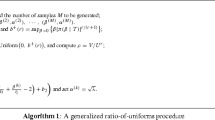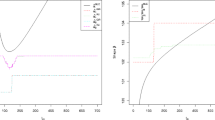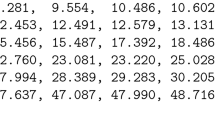Abstract
In this work, we propose the Bayesian estimator for parameters of the Birnbaum-Saunders distribution based on conjugate, Jeffreys, and reference priors that can be implemented quite fast through Gibbs sampler. The Bayesian estimator based on conjugate prior for the Birnbaum-Saunders is new. Performance of the proposed Bayesian paradigm, based on three priors, is demonstrated by simulation and analyzing two sets of real data. Furthermore, it is shown through an extra real example that the Bayesian estimator can outperform the maximum likelihood estimator for the BS distribution when data are incomplete due to the progressive type-II censoring scheme. An R package called bibs has been uploaded to comprehensive R archive network (CRAN) at https://cran.r-project.org/web/packages/bibs/index.html for computing the Bayesian estimator, corresponding standard errors, and credible intervals.




Similar content being viewed by others
References
Achcar JA (1993) Inferences for the Birnbaum-Saunders fatigue life model using bayesian methods. Comput Stat Data Anal 15(4):367–380
Aggarwala R (2001) Progressive interval censoring: some mathematical results with applications to inference. Commun Stat Theory Methods 30(8–9):1921–1935
Balakrishnan N, Aggarwala R (2000) Progressive censoring: theory, methods, and applications. Springer Science & Business Media, New York
Balakrishnan N, Kundu D (2019) Birnbaum-Saunders distribution: a review of models, analysis, and applications. Appl Stoch Models Bus Ind 35(1):4–49
Balakrishnan N, Zhu X (2013) A simple and efficient method of estimation of the parameters of a bivariate Birnbaum-Saunders distribution based on type-II censored samples. In: Kollo T (ed) Multivariate statistics: theory and applications. World Scientific, New Jersey, pp 34–47
Balakrishnan N, Zhu X (2014) On the existence and uniqueness of the maximum likelihood estimates of the parameters of Birnbaum-Saunders distribution based on type-I, type-II and hybrid censored samples. Statistics 48(5):1013–1032
Barros M, Paula GA, Leiva V (2008) A new class of survival regression models with heavy-tailed errors: robustness and diagnostics. Lifetime Data Anal 14(3):316–332
Barros M, Paula GA, Leiva V (2009) An R implementation for generalized Birnbaum-Saunders distributions. Comput Stat Data Anal 53(4):1511–1528
Bernardo JM (1979) Reference posterior distributions for Bayesian inference. J R Stat Soc Ser B 41(2):113–128
Birnbaum ZW, Saunders SC (1969) Estimation for a family of life distributions with applications to fatigue. J Appl Probab 6(2):328–347
Chib S, Greenberg E (1995) Understanding the Metropolis-Hastings algorithm. Am Stat 49(4):327–335
Congdon P (2007) Bayesian statistical modelling. Wiley, Chichester
Darijani S, Zakerzade H, Torabi H (2019) Goodness-of-fit tests for Birnbaum-Saunders distributions. J Iran Stat Soc 18(2):1–20
Dempster AP, Laird NM, Rubin DB (1977) Maximum likelihood from incomplete data via the EM algorithm. J R Stat Soc Ser C 39(1):1–22
Desmond AF (1986) On the relationship between two fatigue-life models. IEEE Trans Reliab 35(2):167–169
Díaz-García JA (2005) A new family of life distributions based on the elliptically contoured distributions. J Stat Plan Inference 128(2):445–457
Dunn PK, Smyth GK (1996) Randomized quantile residuals. J Stat Comput Simul 5(3):236–244
Galea M, Leiva-Sánchez V, Paula G (2004) Influence diagnostics in log-Birnbaum-Saunders regression models. J Appl Stat 31(9):1049–1064
Gilks WR, Best NG, Tan K (1995) Adaptive rejection Metropolis sampling within Gibbs sampling. J R Stat Soc Ser C 44(4):455–472
Good IJ (1953) The population frequencies of species and the estimation of population parameters. Biometrika 40(3–4):237–264
Johnson RA, Wichern DW (1999) Applied multivariate analysis. Prentice-Hall, New Jersey
Johnson NL, Kotz S, Balakrishnan N (1995) Continuous Univariate Distributions, vol 2. Wiley, New York
Kundu D, Balakrishnan N, Jamalizadeh A (2010) Bivariate Birnbaum-Saunders distribution and associated inference. J Multivar Anal 101(1):113–125
Lange K (2010) Numerical analysis for statisticians. Springer, New York
Lawless J (1982) Statistical models and methods for lifetime data. Wiley, New York
Lemonte AJ (2016) A note on the fisher information matrix of the Birnbaum-Saunders distribution. JSTA 15(2):196–205
Lemonte AJ, Cribari-Neto F, Vasconcellos KL (2007) Improved statistical inference for the two-parameter Birnbaum-Saunders distribution. Comput Stat Data Anal 51(9):4656–4681
McLachlan GJ, Krishnan T (2007) The EM algorithm and extensions. Wiley, Hoboken
Neal RM (2003) Slice sampling. Ann Stat 31(3):705–767
Ng H, Kundu D, Balakrishnan N (2003) Modified moment estimation for the two-parameter Birnbaum-Saunders distribution. Comput Stat Data Anal 43(3):283–298
Ng H, Kundu D, Balakrishnan N (2006) Point and interval estimation for the two-parameter Birnbaum-Saunders distribution based on type-II censored samples. Comput Stat Data Anal 50(11):3222–3242
Ortega EM, Cordeiro GM, Lemonte AJ (2012) A log-linear regression model for the \(\beta \)-Birnbaum-Saunders distribution with censored data. Comput Stat Data Anal 56(3):698–718
Owen WJ (2006) A new three-parameter extension to the Birnbaum-Saunders distribution. IEEE Trans Reliab 55(3):475–479
Padgett W, Tomlinson M (2003) Lower confidence bounds for percentiles of Weibull and Birnbaum-Saunders distributions. J Stat Comput Simul 73(6):429–443
Pradhan B, Kundu D (2013) Inference and optimal censoring schemes for progressively censored Birnbaum-Saunders distribution. J Stat Plan Inference 143(6):1098–1108
R Core Team (2018) R: a language and environment for statistical computing. R Foundation for Statistical Computing, Vienna, Austria
Rieck JR (1995) Parameter estimation for the Birnbaum-Saunders distribution based on symmetrically censored samples. Commun Stat Theory Methods 24(7):1721–1736
Sha N, Ng TL (2017) Bayesian inference for Birnbaum-Saunders distribution and its generalization. J Stat Comput Simul 87(12):2411–2429
Teimouri M (2021) bccp: an R package for life-testing and survival analysis. Comput Stat. https://doi.org/10.1007/s00180-021-01129-9
Teimouri M, Nadarajah S (2016) Bias corrected mles under progressive type-II censoring scheme. J Stat Comput Simul 86(14):2714–2726
Teimouri M, Hosseini SM, Nadarajah S (2013) Ratios of Birnbaum-Saunders random variables. Qual Technol Quant Manag 10(4):457–481
Tsionas EG (2001) Bayesian inference in Birnbaum-Saunders regression. Commun Stat Theory Methods 30(1):179–193
Wang BX (2012) Generalized interval estimation for the Birnbaum-Saunders distribution. Comput Stat Data Anal 56(12):4320–4326
Wang Z, Desmond AF, Lu X (2006) Modified censored moment estimation for the two-parameter Birnbaum-Saunders distribution. Comput Stat Data Anal 50(4):1033–1051
Wang M, Sun X, Park C (2016) Bayesian analysis of Birnbaum-Saunders distribution via the generalized ratio-of-uniforms method. Comput Stat 31(1):207–225
Xu A, Tang Y (2010) Reference analysis for Birnbaum-Saunders distribution. Comput Stat Data Anal 54:185–192
Xu A, Tang Y (2011) Bayesian analysis of Birnbaum-Saunders distribution with partial information. Comput Stat Data Anal 55(7):2324–2333
Funding
This research received no funding.
Author information
Authors and Affiliations
Corresponding author
Ethics declarations
Conflict of interest
The author declares no conflict of interest.
Additional information
Publisher's Note
Springer Nature remains neutral with regard to jurisdictional claims in published maps and institutional affiliations.
Appendices
Appendix A. Proof of Lemma 2.1
It is known that the pdf of each BS distribution can be represented as a two-component IG distribution with equal mixing (weight) parameters (Desmond 1986). In the following, Lemma 2.1 represents this property in terms of GIG distribution. To do this, we have
It should be noted that \(\text {K}_{\lambda }(.)\) function is an even function with respect to \(\lambda \). This means that \(\text {K}_{-1/2}\bigl (1/\alpha ^2\bigr )=\text {K}_{1/2}\bigl (1/\alpha ^2\bigr )\). It follows that
where \({{{\mathcal {K}}}}\) is a positive constant. Substituting \({{{\mathcal {K}}}}\) in the right-hand side of (A1) and integrating both sides with respect to t yields
This means that \({{{\mathcal {K}}}}=\text {K}_{1/2}\bigl (1/\alpha ^2\bigr )=\text {K}_{-1/2}\bigl (1/\alpha ^2\bigr )=1/2\) and result follows.
Appendix B. Proof of Lemma 2.2
From Lemma 2.1, we know that each BS distribution can be represented as the convex combination of two GIG distributions. Define a latent variable \(Z\sim {\text {Bernoulli}}(\)p=0.5) for each observed value such as \(t_i\) (for \(i=1,\cdots ,n\)) to show that \(t_i\) comes from the first component if \(z_i=1\), otherwise \(t_i\) comes from the second component. So, it follows from Lemma 2.1 that, \(T_i|Z_i=1 \sim \text {GIG}(1/2,\beta /\alpha ^2,1/(\alpha ^2\beta ))\) and \(T_i|Z_i=0 \sim \text {GIG}(-1/2,\beta /\alpha ^2,1/(\alpha ^2\beta ))\). For the complete data likelihood, we can write
We note that \(z_i\) in right-hand side of (B1) comes from the full conditional given by
Some simple algebra shows
The result follows.
Appendix C. Algorithm for computing the Bayesian estimator using the reference prior
-
(1)
Read M and \({\varvec{t}}=\bigl (t_1,t_2,\cdots ,t_n\bigr )^{'}\). Define st=\(\sum _{i=1}^{n} t_i\) and rst=\(\sum _{i=1}^{n}1/t_i \) and set the initial values of \(\beta \) and \(\alpha \) as \(\beta _0=\sqrt{\text {st}/\text {rst}}\) and \(\alpha _0=\sqrt{\text {st}/(n\beta _0)}+\beta _0\sqrt{\text {rst}}/n-2\), respectively;
-
(2)
Set \(m=0\);
-
(3)
For each \(t_i\), simulate \(z_i \sim \text {Bernoulli}(p_{i})\) where \(p_{i}=t_{i}/\bigl (\beta _{m}+t_{i}\bigr )\) (for \(i=1,2,\cdots ,n\)) and set \(\text {sz}=\sum _{i=1}^{n} z_{i}\);
-
(4)
Update \(\beta \) as \(\beta _{m+1}\) by generating from \(\text {GIG}\bigl (\lambda = n/2 - \text {sz}, \chi = \text {st}/\alpha _{m}^{2}, \psi = \text {srt}/\alpha _{m}^{2}\bigr )\);
-
(5)
Update \(\alpha \) as \(\alpha _{m+1}\) by generating from \(\sqrt{ \text {IG}\bigl ( n/2, \text {rate}\bigr )}\) where \(\text {rate}=\text {st}/(2\beta _{m+1}) + \beta _{m+1}\text {rst}/2 - n\);
-
(6)
If \(m=M\), then go to the next step, otherwise set \(m=m+1\) and repeat the algorithm from step (3);
-
(7)
Set \(\sum _{m=M_{0}}^{M} \alpha _{m}/(M-M_{0}+1)\), \(\sum _{m=M_{0}}^{M} \beta _{m}/(M-M_{0}+1)\) as Bayesian estimators of \(\alpha \) and \(\beta \), respectively.
Appendix D. Algorithm for computing the Bayesian estimator using the conjugate prior
-
(1)
Read M and \({\varvec{t}}=\bigl (t_1,t_2,\cdots ,t_n\bigr )^{'}\). Define st=\(\sum _{i=1}^{n} t_i\) and rst=\(\sum _{i=1}^{n}1/t_i \) and set the initial values of \(\beta \) and \(\alpha \) as \(\beta _0=\sqrt{\text {st}/\text {rst}}\) and \(\alpha _0=\sqrt{\text {st}/(n\beta _0)}+\beta _0\sqrt{\text {rst}}/n-2\), respectively;
-
(2)
Set \(m=0\);
-
(3)
For each \(t_i\), simulate \(z_i \sim \text {Bernoulli}(p_{i})\) where \(p_{i}=t_{i}/\bigl (\beta _{m}+t_{i}\bigr )\) (for \(i=1,2,\cdots ,n\)) and set \(\text {sz}=\sum _{i=1}^{n} z_{i}\);
-
(4)
Update \(\beta \) as \(\beta _{m+1}\) by generating from \(\text {GIG}\bigl (\lambda = n/2 - \text {sz} + \lambda _0, \chi = \text {st}/\alpha _{m}^{2} + \chi _0, \psi = \text {srt}/\alpha _{m}^{2} + \psi _0\bigr )\);
-
(5)
Update \(\alpha \) as \(\alpha _{m+1}\) by generating from \(\sqrt{ \text {IG}\bigl ( n/2 + \gamma _0, \text {rate}\bigr )}\) where \(\text {rate}=\text {st}/(2\beta _{m+1}) + \beta _{m+1}\text {rst}/2 - n + \theta _0\);
-
(6)
If \(m=M\), then go to the next step, otherwise set \(m=m+1\) and repeat the algorithm from step (3);
-
(7)
Set \(\sum _{m=M_{0}}^{M} \alpha _{m}/(M-M_{0}+1)\), \(\sum _{m=M_{0}}^{M} \beta _{m}/(M-M_{0}+1)\) as Bayesian estimators of \(\alpha \) and \(\beta \), respectively.
Appendix E. Algorithm for computing the Bayesian estimator using the Jeffreys prior
-
(1)
Read M and \({\varvec{t}}=\bigl (t_1,t_2,\cdots ,t_n\bigr )^{'}\). Define st=\(\sum _{i=1}^{n} t_i\) and rst=\(\sum _{i=1}^{n}1/t_i \) and set the initial values of \(\beta \) and \(\alpha \) as \(\beta _0=\sqrt{\text {st}/\text {rst}}\) and \(\alpha _0=\sqrt{\text {st}/(n\beta _0)}+\beta _0\sqrt{\text {rst}}/n-2\), respectively;
-
(2)
Set \(m=0\);
-
(3)
For each \(t_i\), simulate \(z_i \sim \text {Bernoulli}(p_{i})\) where \(p_{i}=t_{i}/\bigl (\beta _{m}+t_{i}\bigr )\) (for \(i=1,2,\cdots ,n\)) and set \(\text {sz}=\sum _{i=1}^{n} z_{i}\);
-
(4)
Update \(\beta \) as \(\beta _{m+1}\) by generating from \(\text {GIG}\bigl (\lambda = n/2 - \text {sz}, \chi = \text {st}/\alpha _{m}^{2}, \psi = \text {srt}/\alpha _{m}^{2}\bigr )\);
-
(5)
Simulate x form pdf \(\omega f_{\text {IG}}(x|\gamma _{1}^{*},\theta ^{*}) + (1-\omega ) f_{\text {IG}}(x|\gamma _{2}^{*},\theta ^{*})\), where \(\omega =1/\bigl (1+2\theta ^{*}/n\bigr )\), \(\gamma _{1}^{*}=n/2\), \(\gamma _{2}^{*}=(n-1)/2\), and \(\theta ^{*}=\sum _{i=1}^{n}t_i/(2\beta _{m+1})+\beta _{m+1}\sum _{i=1}^{n}t^{-1}_{i}/2-n\);
-
(6)
If \(u<\sqrt{1 + z/4}/(1 + \sqrt{z}/2)\), where \(u \sim Uniform(0,1)\) and \(z=\sqrt{x}\), then \(\alpha _{m+1}=z\) and go to the next step, otherwise repeat algorithm from step (5);
-
(7)
If \(m=M\), then go to the next step, otherwise set \(m=m+1\) and repeat the algorithm from step (3);
-
(8)
Set \(\sum _{m=M_{0}}^{M} \alpha _{m}/(M-M_{0}+1)\), \(\sum _{m=M_{0}}^{M} \beta _{m}/(M-M_{0}+1)\) as Bayesian estimators of \(\alpha \) and \(\beta \), respectively.
Appendix F. Fisher information matrix
Here, we derive the Fisher information (FI) matrix for the BS distribution. First, we give expressions for the FI matrix when the Bayesian inference is based on the conjugate, reference, and Jeffreys priors. Suppose we consider conjugate prior for joint distribution of \(\alpha \) and \(\beta \) as \(\pi _c(\alpha ,\beta )=\pi _c(\alpha )\pi _c(\beta )\). Based on the conjugate prior, the log-likelihood of joint posterior pdf is
Let \({I}^{(c)}(\alpha ,\beta )=(I^{(c)}_{ij})_{i,j=1,2}\) where \(I^{(c)}_{11}(\alpha ,\beta )=-E(\partial ^2l^{{{(c)}}}(\alpha ,\beta |{\varvec{t}})/\partial {\alpha } \partial {\alpha })\), \(I^{(c)}_{22}(\alpha ,\beta )=-E(\partial ^2l^{{{(c)}}}(\alpha ,\beta |{\varvec{t}})/\partial {\beta } \partial {\beta })\), and \(I^{(c)}_{12}(\alpha ,\beta )=I^{(c)}_{21}(\alpha ,\beta )=-E(\partial ^2l^{{{(c)}}}(\alpha ,\beta |{\varvec{t}})/\partial {\alpha } \partial {\beta })\) are elements of the FI matrix. It follows that
where
with
are given by Lemonte (2016). It turns out that
Note that for \(0<\alpha <0.3\), \(h(\alpha )\) in (F4) is replaced with
as suggested by Lemonte (2016). Likewise, based on reference prior \(\pi _{r}(\alpha ,\beta )=1/(\alpha \beta )\), we can write
Let \({I}^{(r)}(\alpha ,\beta )=(I^{(r)}_{ij})_{i,j=1,2}\) where \(I^{(r)}_{11}(\alpha ,\beta )=-E(\partial ^2l^{{{(r)}}}(\alpha ,\beta |{\varvec{t}})/\partial {\alpha } \partial {\alpha })\), \(I^{(r)}_{22}(\alpha ,\beta )=-E(\partial ^2l^{{{(r)}}}(\alpha ,\beta |{\varvec{t}})/\partial {\beta } \partial {\beta })\), and \(I^{(r)}_{12}(\alpha ,\beta )=I^{(r)}_{21}(\alpha ,\beta )=-E(\partial ^2l^{{{(r)}}}(\alpha ,\beta |{\varvec{t}})/\partial {\alpha } \partial {\beta })\) are elements of the FI matrix based on reference prior. It follows that
where \(K_{\alpha \alpha }\), \(K_{\alpha \beta }\), and \(K_{\beta \beta }\) are given in (F1), (F2), and (F3), respectively. Then more algebra shows
Finally, for the case of Jeffreys prior given in (5), we have
Let \({I}^{(J)}(\alpha ,\beta )=(I^{(J)}_{ij})_{i,j=1,2}\) where \(I^{(J)}_{11}(\alpha ,\beta )=-E(\partial ^2l^{{{(J)}}}(\alpha ,\beta |{\varvec{t}})/\partial {\alpha } \partial {\alpha })\), \(I^{(J)}_{22}(\alpha ,\beta )=-E(\partial ^2l^{{{(J)}}}(\alpha ,\beta |{\varvec{t}})/\partial {\beta } \partial {\beta })\), and \(I^{(J)}_{12}(\alpha ,\beta )=I^{(J)}_{21}(\alpha ,\beta )=-E(\partial ^2l^{{{(J)}}}(\alpha ,\beta |{\varvec{t}})/\partial {\alpha } \partial {\beta })\) are elements of the FI matrix based on Jeffreys prior. It follows that
Then more algebra shows
Rights and permissions
About this article
Cite this article
Teimouri, M. Fast Bayesian Inference for Birnbaum-Saunders Distribution. Comput Stat 38, 569–601 (2023). https://doi.org/10.1007/s00180-022-01234-3
Received:
Accepted:
Published:
Issue Date:
DOI: https://doi.org/10.1007/s00180-022-01234-3




